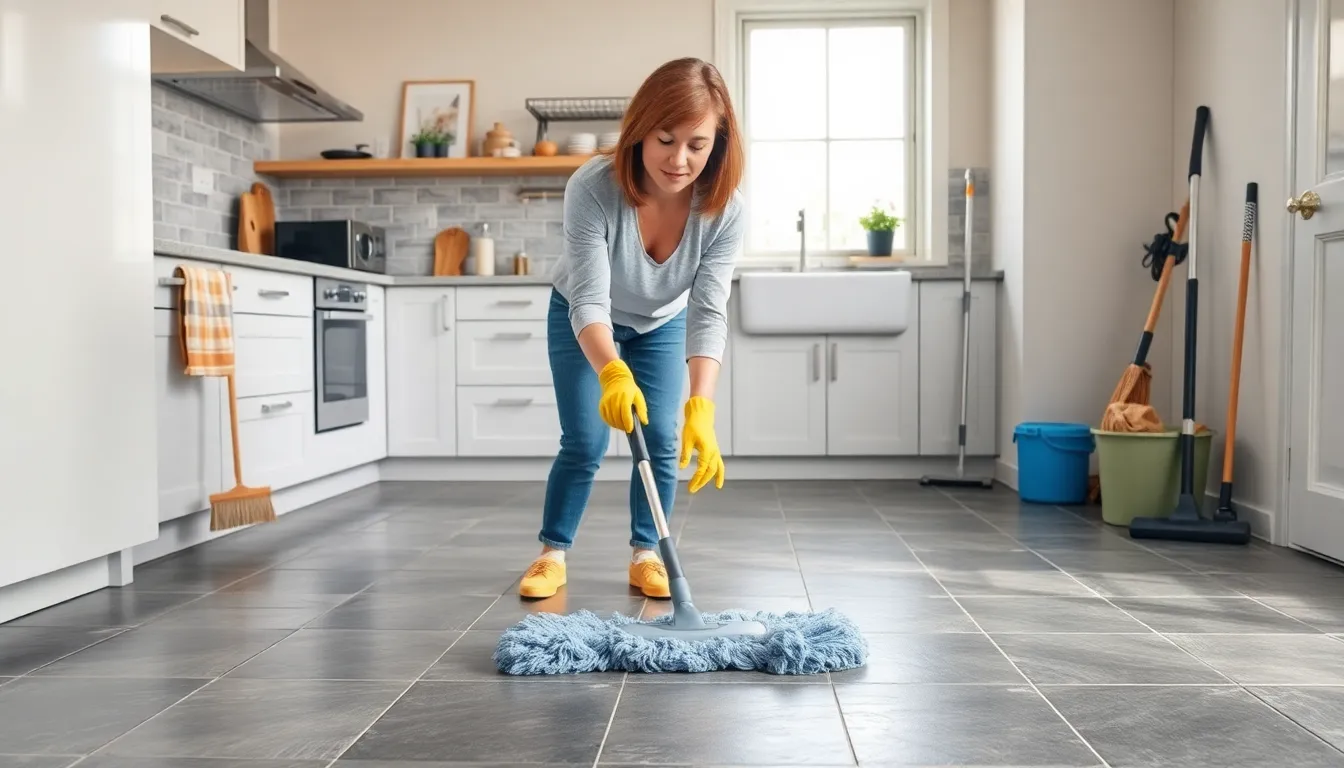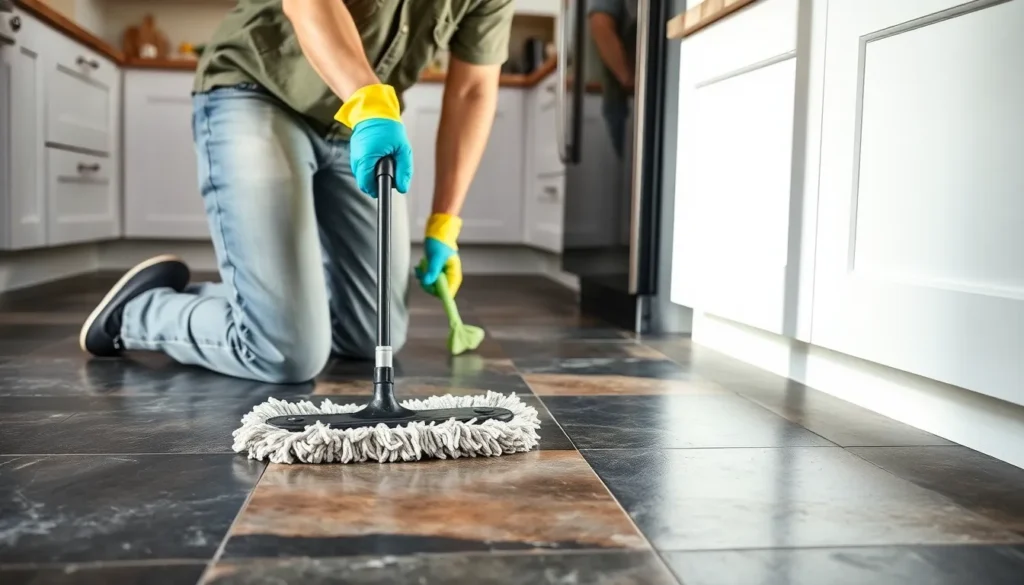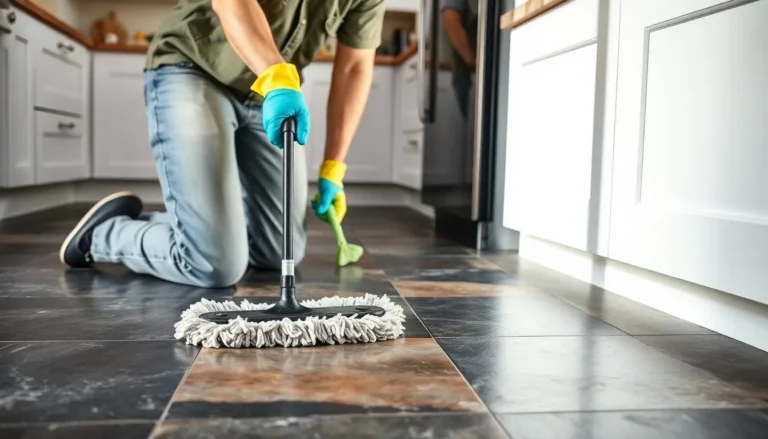Slate floors are like that friend who shows up to the party looking effortlessly cool but requires a bit of TLC to keep shining. While they add a touch of elegance to any space, they can also become a magnet for dirt and grime. Cleaning them might seem daunting, but fear not! With the right tips and tricks, you can have those floors gleaming brighter than your neighbor’s questionable holiday lights.
Table of Contents
ToggleUnderstanding Slate Floors
Slate floors offer unique beauty and durability, making them a popular choice for homes. Cleaning these surfaces requires an understanding of their characteristics and benefits.
Characteristics of Slate
Slate consists of natural stone formed from clay and minerals through intense heat and pressure. This process gives slate its distinctive layered appearance. Colors range from gray and blue to green and red, providing diverse design options. Texture varies, with some pieces smooth while others boast a more rustic feel. Its density contributes to a sturdy surface, suitable for high-traffic areas. Slate’s natural slip resistance adds safety in spaces like kitchens and bathrooms.
Benefits of Slate Flooring
Slate flooring enhances aesthetics with its rich colors and textures that complement various interior styles. Long-lasting durability makes slate a smart investment, often lasting decades with proper care. Environmentally friendly, slate is a natural material, reducing synthetic product reliance. Maintenance requires minimal effort compared to softer surfaces, helping homeowners save time. Its thermal properties provide a cool surface in warmer months, while retaining warmth in cooler seasons. Additionally, slate adds value to a property, appealing to potential buyers due to its timeless elegance.
Preparing to Clean Slate Floors

Preparation is key for effective slate floor cleaning. Properly gathering supplies and assessing the floor’s condition ensures optimal results.
Gathering Supplies
Essential cleaning supplies include a broom, vacuum, mild detergent, and microfiber mop. Using a suitable pH-balanced cleaner helps protect slate from damage. Rubber gloves provide hand protection, while soft-bristle brushes address stubborn stains without scratching the surface. Bucket and water are vital for rinsing and cleaning to remove dirt effectively. Gathering all these items before starting simplifies the cleaning process, making it smoother and more efficient.
Assessing the Floor Condition
Before cleaning, it’s important to assess the slate floor’s condition. Check for cracks, scratches, or loose tiles that need repair. Identifying problem areas helps determine the best cleaning approach. Noticing any accumulated grime or stains indicates the level of cleaning required. Evaluating the floor’s finish ensures the right cleaning products are used without causing damage. This thorough assessment helps in planning an effective cleaning strategy, protecting the slate’s beauty.
Step-by-Step Cleaning Process
Cleaning slate floors requires a systematic approach. Implementing this process ensures cleanliness and preservation of the slate’s natural beauty.
Sweeping and Dusting
Begin the cleaning routine by sweeping or dusting the slate floors. Use a broom with soft bristles to avoid scratching the surface. Microfiber dusters effectively capture dirt and dust particles. Prioritize thorough coverage to eliminate loose debris. Focus on corners and edges, as dirt tends to accumulate in these areas. Regularly sweeping prevents buildup and simplifies subsequent cleaning stages.
Wet Mopping
For the wet mopping stage, select a pH-balanced cleaner specifically designed for natural stone. Mix the cleaner with warm water according to the manufacturer’s instructions. Use a microfiber mop to apply the solution evenly across the floor. Ensure the mop is damp, not dripping, to prevent excess water damage. Clean one section at a time, rinsing the mop frequently to avoid spreading dirt. Allow the floor to dry completely, which aids in maintaining slate’s slip resistance.
Dealing with Stains
Addressing stains requires prompt attention. Identify the stain type to select an appropriate cleaning method. For oil-based stains, use a gentle degreaser or a poultice made from baking soda and water. Apply the poultice to the stain and cover it with plastic wrap for several hours. For stubborn stains, enlist a soft-bristle brush to carefully scrub the area without damaging the slate. Always rinse the affected spot thoroughly and dry it afterward to prevent residue buildup.
Maintenance Tips for Slate Floors
Maintaining slate floors requires consistent care to preserve their beauty and functionality.
Regular Cleaning Schedule
Establish a cleaning routine every week to prevent dirt buildup. Sweeping or vacuuming remains essential to remove loose debris, targeting high-traffic areas. Mopping with a pH-balanced cleaner diluted in warm water enhances the floor’s shine without causing damage. Incorporating this practice regularly helps avoid stubborn stains. Inspecting the floor during cleaning sessions allows for early detection of wear or damage, enabling prompt repairs. By sticking to a consistent schedule, it’s easier to keep slate floors looking pristine.
Best Practices to Avoid Damage
Avoid harsh chemicals that can harm the slate’s surface. Using mats at entry points significantly reduces dirt and grit tracked indoors. It’s important to prevent sharp objects from scraping the slate while moving furniture or equipment. Choosing soft-bristle brushes for scrubbing helps protect the floor’s finish. Applying a sealant periodically enhances stain resistance and prolongs the life of the slate. Additionally, ensuring wet mops are damp, not soaking, prevents excess water damage. Following these best practices helps maintain the unique beauty and durability of slate floors.
Maintaining slate floors doesn’t have to be a daunting task. With the right cleaning techniques and regular upkeep, they can remain a stunning feature in any home. By using pH-balanced cleaners and following a consistent cleaning schedule, homeowners can prevent dirt buildup and preserve the slate’s natural beauty.
Regular inspections during cleaning can catch potential issues early, ensuring the longevity of the flooring. Simple practices like using mats and avoiding harsh chemicals can further protect these elegant surfaces. With a little care, slate floors will continue to enhance the aesthetic appeal of any space while standing the test of time.










